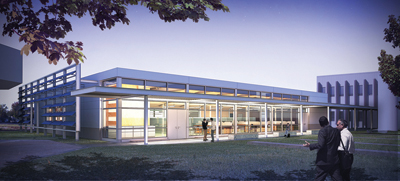More than 20 years ago, then-director of the Combustion Research Facility (CRF) Peter Mattern had a vision for a complex that would include both experimental labs and a facility dedicated to predictive modeling and simulation. On March 24, that dream started to take shape as reality as the first mounds of dirt were moved at a groundbreaking ceremony for the Combustion Research Computation and Visualization (CRCV) building.

ARCHITECTURAL RENDERING of the new Combustion Research Computation and Visualization (CRCV) building. (Rendering courtesy of Flad Architects)
“People have had this vision for a while, recognizing the need to develop predictive simulation as a way to move forward because you can’t measure everything,” said CRF director Bob Carling (8300). “Technology and innovation must evolve more rapidly than through experiments alone in order to meet our energy goals. Predictive modeling is a key enabler for the transportation industry, so this new computational facility will be an integral part of our efforts.”
He credited Andy McIlroy (1800), acting director for Materials Science and Engineering, and acting senior manager Dawn Manley (8350) with putting together the vision for the CRCV and seeing the project through to the end.
Cofunded by DOE’s Office of Science and Office of Energy Efficiency and Renewable Energy, designed by Flad Architects, and under construction by BN Builders, the 8,400-square-foot facility will offer offices, visualization equipment, collaboration space, and 2,000 square feet of dedicated space for high-performance computing clusters (see Lab News, Aug. 14, 2009, page 6). Construction should be complete by the end of the year.
First-principle direct numerical simulation
The CRCV facility will support high-fidelity numerical simulations and the building and testing of models that require highly intensive computational capabilities. Simulations will include first-principles direct numerical simulations of turbulent flames, which allow for the examination of fine-scale coupling between turbulence and chemistry interactions. Large eddy simulations will enable modeling of the entire engine intake and combustion chamber, as well as the smaller-scale transport and chemistry issues.
Div. 8000 VP Rick Stulen welcomed guests from DOE, Sandia/New Mexico, and the city of Livermore to the groundbreaking ceremony. Also in attendance were two former CRF directors, Peter Mattern and Bill McLean.
“The Combustion Research Facility represents a phenomenal partnership between very fundamental science and applied science, one that has lasted over 25 years and is unique within the national laboratories,” said Rick. “It is this combination that makes this a very special place.”
He described the predictive modeling and simulation capabilities of the CRF as essential to help meet the challenges laid down by President Obama: an 80 percent reduction in CO2 emissions by 2050 and a 25 percent reduction in the consumption of liquid petroleum. This was a theme that the other speakers carried through their talks.
“For a long time we’ve recognized that the path to success is through truly predictive combustion models,” said Eric Rohlfing, director of chemical sciences, geosciences, and biosciences for DOE’s Office of Basic Energy Science. “As much as it pains me to say this as an experimentalist, we’ll never measure everything. We need to come up with ways to understand the details and complex interplay between turbulence and chemistry in modern engines with new fuels. I’m delighted that we’ve been able to partner with our colleagues in the vehicle technology program to provide the funding for this building.”
A new way of managing construction
CRCV is not just a new facility at the California site, it also represents a new way of managing construction for Sandia. Dan Sanchez, an NNSA/Sandia Site Office (SSO) senior manager, spoke about the new oversight model that gives Sandia more control. He likened the change to a parent giving up car keys to a teenager.
“We are taking a backseat approach while providing guidance and all of the support that Sandia needs to be successful in this particular project,” he said. “This new oversight process is a reflection of our confidence at SSO in Sandia’s abilities to manage a large construction project.”
Joining Rick to wield the shovels at the groundbreaking were CRF director Bob Carling (8000); Andy; Dawn; senior manager Art Pontau (8360); Bill; Peter; Sanchez; Rohlfing; Gurpreet Singh, team leader for the advanced combustion engine technologies vehicle technology program; Livermore Mayor Marshall Kamena; city manager Linda Barton; Mike White, the director of economic development for the city of Livermore; John Mickow and Andrew Slusser of Flad Architects; and Mike Anderson and Paul Gryfakis of BN Builders.